THE LANDSCAPING SOLUTIONS BLOG
Welcome to our Blog. Inspiration, updates and industry trends from the team at Landscaping Solutions.
LANDSCAPING SOLUTIONS HELPS YOU TO TACKLE CLIMATE CHANGE
Futurescape is a leading event in the garden landscaping and design world. This year’s event, held last month, included a Summit addressing what the industry might do to combat climate change.
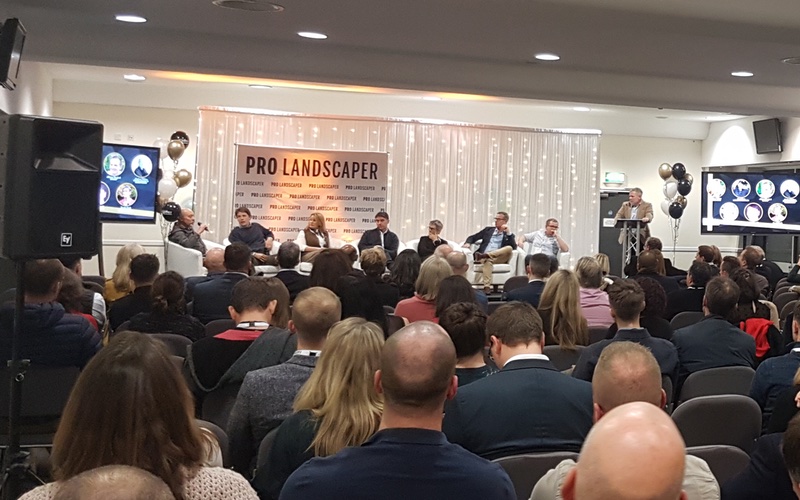
A packed Summit at Futurescape 2019. Ben West (second from left) on stage with Andrew Wilson, Sarah Eberle, Katya Griffiths, Paul Cowell and Alistair Bayford.
On stage were Landscaping Solutions’ Ben West, alongside industry leading lights and award-winning designers Sarah Eberle, Alistair Bayford and Andrew Wilson, President of the Landscape Institute Adam White, garden designer Katya Griffiths, Chartered Landscape Architect Paul Cowell and the Landscape Institute’s Noel Farrer.
Chances are that Climate Change is a shadow that hangs over you in some form or other. It’s difficult to avoid, as each day another worry seems to be added to the list of environmental damage: habitat destruction, plastic pollution, chemicals in the food...
The good news is that garden-owners are perfectly placed to play a part in creating a solution. “Gardens cover a larger area that Nature reserves in this country,” says Ben. “As the wider and wilder landscape becomes eaten up by development and intensive farming, gardens have become highly important last refuges for wildlife.”
It’s not about having the garden that doesn’t suit you, though. There are so many small changes that can add up to a greater impact. At the Summit, Andrew Wilson said, “Are we all going to change world tomorrow? It has to be incremental. If there’s a moment when ‘incremental’ can happen, it has to be now. Planting may be a garden at a time or a verge at a time, but that’s better than nothing.”
This is why it’s important to select a garden designer or landscaper with care, to find someone who is interested and knowledgeable in making a garden sustainable, for both you and Nature.
It’s an approach encapsulated in Sarah Eberle’s words at the Summit. “It’s about Man’s relationship with Nature, about our protection of Nature and what Nature can do for Humanity.”
The good news is that, as a garden-owner, there are garden designers and landscapers who are already ahead of the game. The Society of Garden Designers has started a programme of advice to members to enable more informed decisions on materials. A well-qualified designer will understand the plants that will suit your area best, and what will be useful for pollinators and attract birds to the garden.
Landscapers with an interest in their environmental impact buy hard landscaping from sustainable suppliers and environmentally sound businesses; they research and practise sustainable construction methods, reduce cement use and carry out environmental audits of their business.
Here at Landscaping Solutions, we do all these things and work with a number of SGD members. Nature-Friendly Garden Design is a speciality of ours. We can advise on how to reduce environmental impact, how reusing and recycling materials and keeping excavated soil on site can save money, reducing the need to hire skips and pay waste costs.
“What will you do tomorrow?” was the final question asked at the Summit. Sometimes, it can be hard to think of changes we can realistically make to help the climate change agenda. But if you’re thinking of redesigning your garden, then choosing designers and landscapers who will help find the most sustainable solutions alongside the stunning design you want is the first step.
“We are the superheroes of tomorrow,” said Alistair Bayford at the Summit. Join us in being a superhero to your garden.
For more information on how we can help create a sustainable, nature-friendly design that gives you the garden you want, contact Ben on 0208 241 2402 or email info@landscapingsolutionsltd.co.uk.
NATURE-FRIENDLY GARDEN DESIGN A SPECIALITY
Do you secretly long for a more Nature-friendly garden but fear the work involved? If you’re a garden designer, do you struggle to inject Nature-friendly elements into a brief because of clients fear it will result in an unwelcome workload?
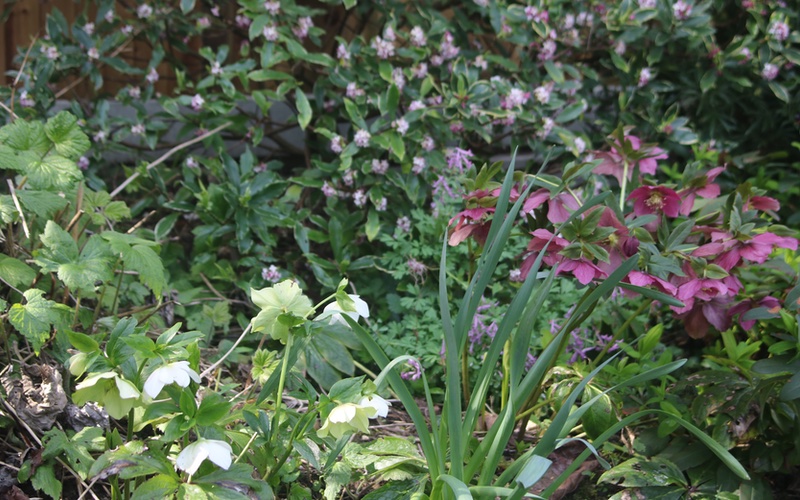
A low-maintenance corner of easy-care shrubs and perennials like the scented daphne (in background) and the hellebores in the foreground offer sustenance to insects early in the year. (Picture: Helen Gazeley)
Gardens are many things: a place to relax, to entertain, a play area for the kids, a haven, perhaps just somewhere for the cats to laze in the sun. Whatever it is, it certainly shouldn’t be a burden.
A garden is also where the natural world comes closest to our lives.
If we allow it to.
Garden-design briefs often veer towards pushing Nature away. Even as the merits of trees and plants in controlling pollution and producing cooling effects, the advantages of wildlife corridors across cities, and the physical and mental health benefits of looking out at a natural scene are increasingly understood and extolled, we lay more artificial grass, cut down trees, and even pave over entire gardens, generally in the interests of Low Maintenance.
Mea culpa!
The Outdoor Room
In part, it is the landscaping industry’s fault. We have spent the last two decades, since Groundforce took TV viewers by storm in the 1990s, describing the garden as an outdoor room, making it out to be an extension of our living space. And while we can certainly extend our day-to-day living into the garden, it is most certainly not a room.
What has been the effect of calling a garden an outdoor room? We suggest that it’s subtly altered expectations, and had a major impact on the look of gardens over the subsequent decades. If the garden is another room, it should look pretty much the same all year round and, if it’s a room, then all it needs is a quick dust, Hoover and tidy-up every so often, just like the lounge indoors.
In many ways this is ideal. Low maintenance is understandably one of the most frequent demands for a garden design, with mowing, weeding, leaf-blowing and pruning kept to an absolute minimum.
But what is missing?
Benefits of a Nature-friendly garden
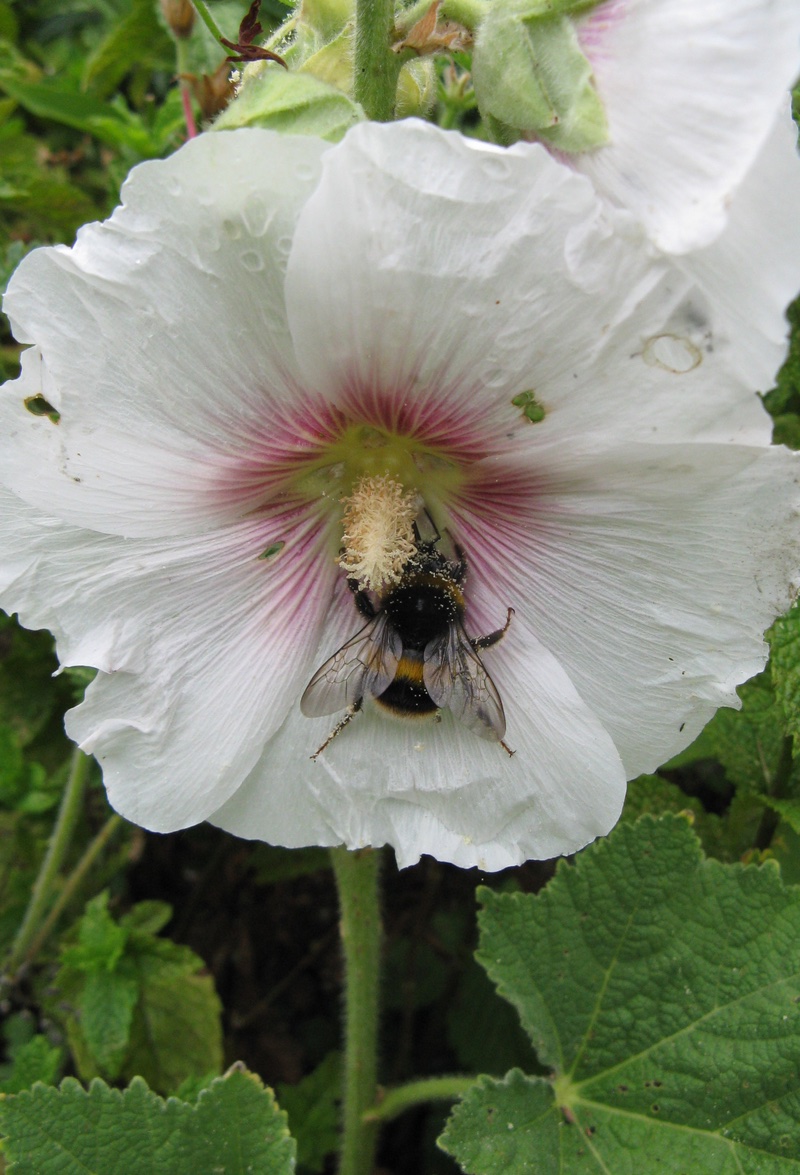
A single flower gives bees the chance to collect pollen where double flower sometimes don't. (Picture: Helen Gazeley)
A nature challenge run by The Wildlife Trusts in 2015 asked participants to do one “wild” activity every day for a month. Participants reported at intervals on how they felt. It turned out that even simple activities like feeding the birds and planting bee-friendly flowers made a difference, with an increase of 30% in participants reporting themselves in excellent health at the end of the challenge.
Other research has demonstrated how a view of nature reduces the need for pain-killers, aids healing, rests the mind and reduces negative emotions.
Children gain enormously from interaction with the natural world. In fact, research into human development portrays childhood as a time when we particularly want to explore it.
And none of the above is possible without the building blocks of a Nature-friendly garden that will attract the wildlife to give you the restorative and stimulating environment that will make a haven for you and a playground for your children.
The landscaping industry’s role?
At Landscaping Solutions we believe that we all have a responsibility towards Nature.
We feel privileged to be part of an industry which is uniquely placed as a bridge between the needs of our clients and the natural world. We can distance people from Nature, or we can create a manageable environment which harmonises with Nature.
If we look after it, it will repay us, with all the benefits listed above.
Client-friendly AND Nature-friendly
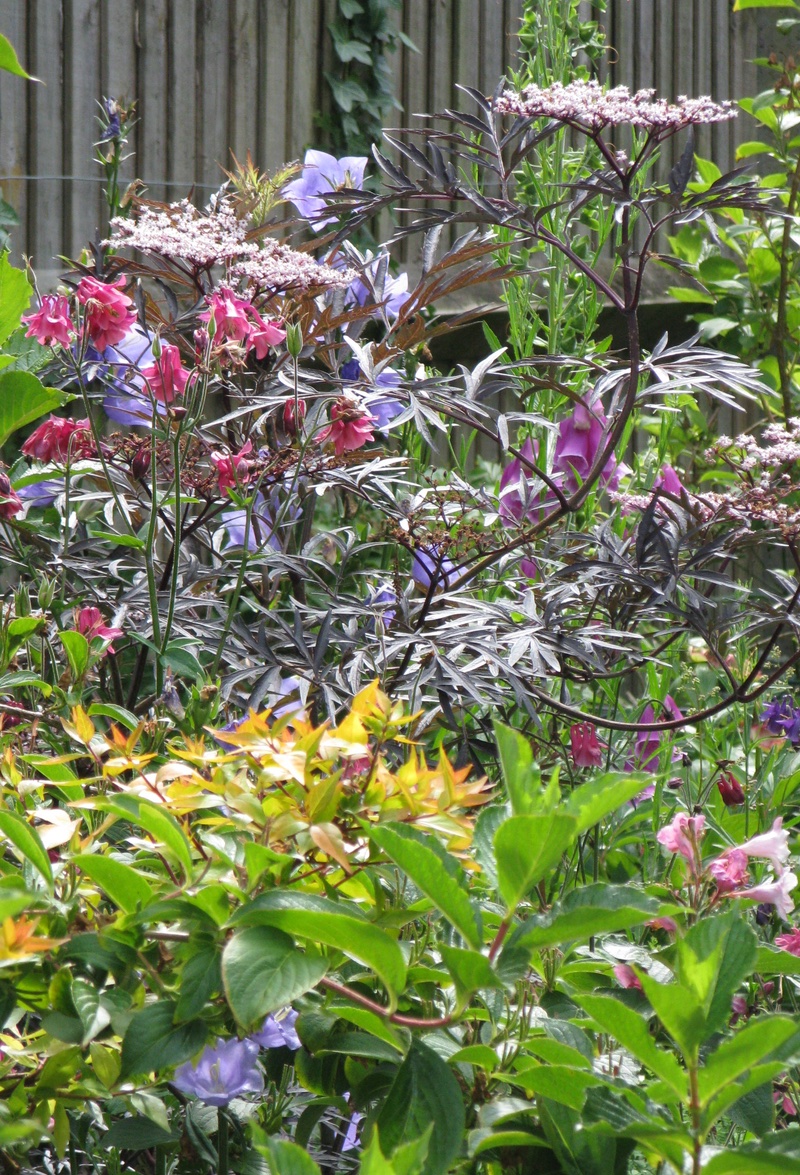
A mix of summer shrubs and self-seeders creates a nectar-rich corner. (Picture: Helen Gazeley)
What does this mean for your garden or, as a designer, your clients’ garden? At Landscaping Solutions, we’re not advocating creating a wilderness outside the back door. We have built award-winning gardens that major on high-quality hard landscaping, with very formal designs and minimalist planting. We’re not going to preach about what should and should be in your or your clients’ garden. However, we choose our materials and plants mindfully.
And this is where we can help. Most garden-design briefs allow plenty of room for nature-friendly elements creating regenerative garden designs that add too, rather than take away from, the environment. They may not be things that you immediately associate with a low-maintenance garden but, if properly installed, they require little attention while enhancing the design, bringing the pleasures of Nature closer to your window, and making a more sustainable design for local flora and fauna.
Here at Landscaping Solutions we have an excellent understanding of how to introduce tiny differences with a big impact, adding a Natural element and yet give you a living space that you can use as part of your daily life and not slave over.
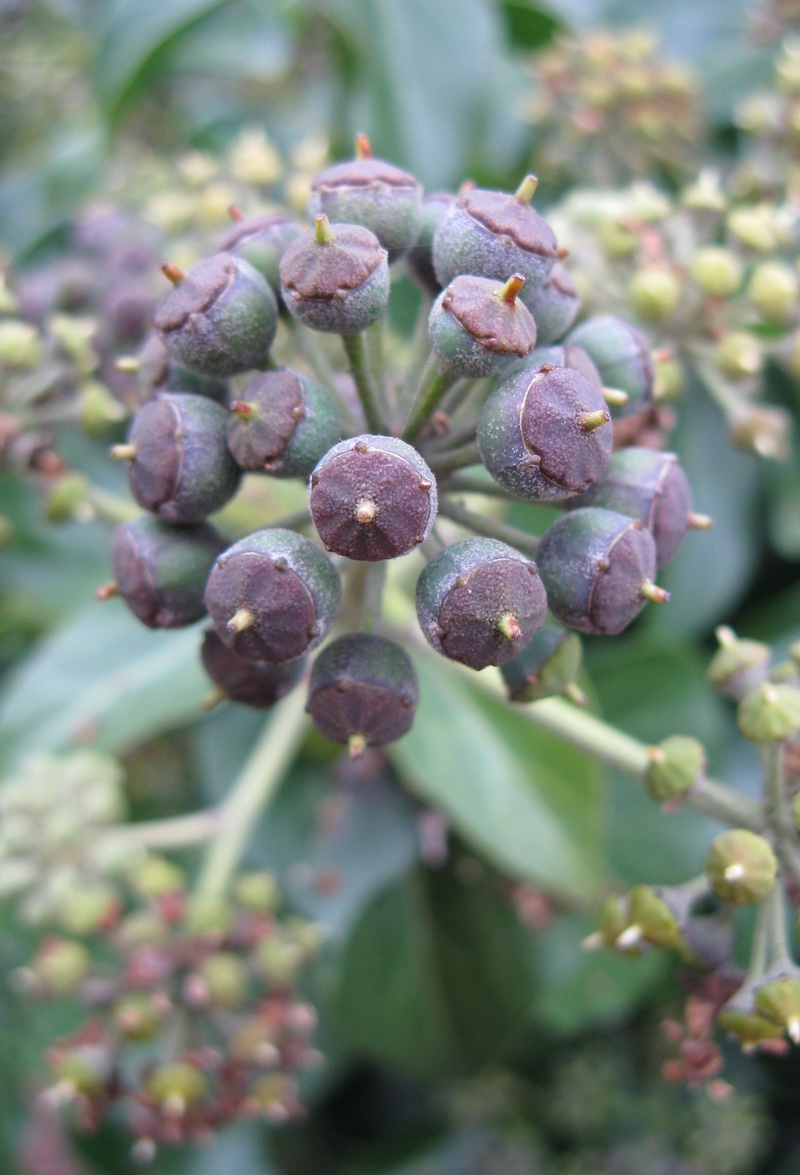
Ivy makes an ideal, easy-to-trim fedge (mix of hedge and fence) and strikingly structural fruit which feeds thrushes in winter. (Picture: Helen Gazeley.)
From choice of productive shrubs, trees and nectar-rich flowering plants that will attract and feed wildlife, choice of grasses and wildflowers for the lawn and minimum grass-cutting regimes, to the installation of safe ponds and small areas of locally appropriate habitat, we have plenty of tools in our toolbox to create a design that will give you an interesting, sustainable garden throughout the year.
We work sympathetically with designers who want to expand the Nature-friendly extent of designs. We can also provide a garden design service. Alternatively, if you would like to make some changes, however small, to your existing garden with a view to supporting wildlife and are wondering what you could reasonably do, we’re happy to advise.
For more information or an informal chat about options, contact Ben West.
STOP PRESS:
At Futurescape on 19th November, Landscaping Solutions’ Ben West will be taking part in the Summit at the end of the day.
A leading industry event, taking place at Sandown Park Racecourse, Surrey, Futurescape brings designers, landscapers and contractors together from all over the UK, creating a stimulating platform for industry debate. Ben will be asking exactly what are our responsibilities as an industry in creating outdoor spaces, and how can we reasonably fulfil them?
A GRAVEL FRONT GARDEN - THE ECONOMICAL, LOW-MAINTENANCE ANSWER TO A SURREY GARDEN OF DISTINCTION
If you’re thinking of putting gravel down in your front garden or driveway, there’s a good chance that you’re attracted by the idea of low maintenance, ease of installation and economy of materials.
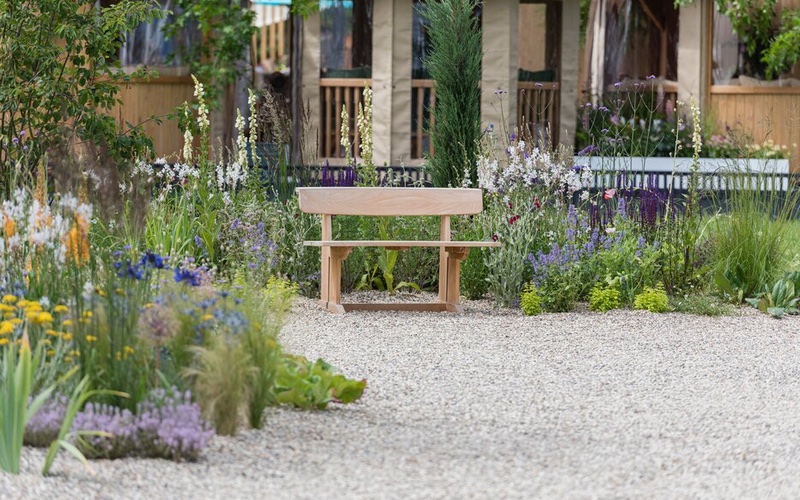
Beth Chatto: The Drought Tolerant Garden. Designed by David Ward. RHS Hampton Court Palace Garden Festival 2019. (Stand no. 200) Copyright © RHS. Credit: RHS/Joanna Kossak. See below why this was the perfect inspiration growing under gravel.
Installed correctly, it’s an ideal material for fulfilling all those criteria, but what’s less recognised is that it can be used to create unique and attractive garden that will, not only incorporate all the practical necessities of a front garden, but will also welcome you home at the end of the day.
Designing a front garden to be both practical and attractive, and maybe look just a little different, can be a challenge. You need enough space for parking, easy access to the road for bins, a surface that works well in all weathers, that’s easy for all types of footwear and wheels to traverse, and that complies with required SUDS regulations, removing the potential need for planning permission. Low maintenance requirements are also usually a priority for this area.
Understandably, the practicalities generally take precedence, even to the extent of the whole frontage being given over to hard landscaping. But there are alternatives.
In this article we’ll look at one of the most unusual and one of the most economical to create - the gravel front garden.
A Gravel Garden, not just a Gravel Driveway
Of course, we’re all used to gravel driveways - plenty of which give gravel a bad name. Badly installed, they leak stones onto the pavement, grow weeds with enthusiasm and settle into ridges under the car wheels while, in a worst-case scenario, being extremely hard work to walk on.
By contrast, a well-designed and expertly installed gravel garden will be low maintenance, solid underfoot where it needs to be, won’t migrate, and will offer a lower-cost option that grows a diversity of planting, therefore giving your house a frontage that has all you need and is welcoming and attractive.
Making Gravel Driveways Work
So, how are the gravel driveway problems listed above solved? By using a stabilisation system in combination with the right type of gravel. Here at Landscaping Solutions, we are registered installers of CEDAdrive, the invisible gravel stabilisation system that creates a surface that is very easy to walk on, even in high heels, and is wheelchair- and pushchair-friendly.
It also solves practical issues relating to SUDS and planning permission.
A Quick Word about SUDS
SUDS - Sustainable Urban Drainage Systems - replicate natural drainage, diverting water away from sewers, with the intention of taking pressure off the sewerage system and reducing surface flooding. The system is a requirement in all front garden developments, with more than five square metres of hard landscaping permitted only where the surface is permeable or there is a permeable area for the water to drain into.
We’ll go into SUDS in more depth in a later article. However, gravel front gardens are completely permeable, allowing rainwater to percolate virtually unimpeded into the soil, and therefore fulfil all the criteria with no need for planning permission.
A Gravel Garden by Design
For an idea of how it could look, this year’s Hampton Court Palace Garden Festival in Surrey provided a perfect example.
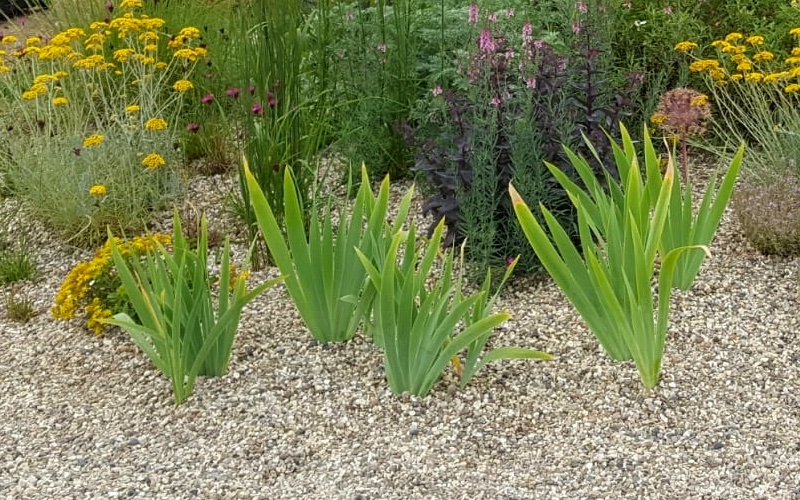
The sword-shaped leaves of irises make a bold statement against gravel in the Beth Chatto Garden at Hampton Court Palace Garden Festival 2019. Picture credit: Ben West.
Beth Chatto, who died in 2018, was one of the most influential gardeners of the twentieth century. In homage, the festival named her its 2019 Horticultural Hero and featured a recreation of her Drought-Tolerant Garden by David Ward, Garden Director of the Beth Chatto Gardens in Elmstead, near Colchester, Essex.
“I loved the Beth Chatto garden,” says Landscaping Solutions’ director Ben West. “It was mainly naturalistic, colourful, vibrant, with lots of different textures and shapes.”
It included a huge number of plants which thrive under gravel and provided a huge variety of plants which make ideal choices for a front garden design. Included in the planting were easy-to-grow herbs like fennel, lavender, thyme, rosemary, oregano, sage and catmint; the edible brassica sea kale; plants like lamb’s ears, whose furry leaves beg to be stroked; colourful flowers like red-hot Helianthemums, misty-blue Perovskias, and the sunshine yellow Verbascums, punctuated by the pure white flowers of such plants as perennial stocks. This is just the tip of the iceberg as far as choices are concerned.
They’ll even multiply without your intervention. Self-seeding is only a problem when it happens in the wrong place. A huge advantage of installing CEDAdrive is the inbuilt geomembrane that separates the gravel from the soil below, preventing deep-rooting plants taking hold. If other plants show their heads, they just lift away from the 40mm depth of gravel.
A complete gravel front garden
Use of CEDAdrive means that those parts of your front garden that need to be walked on, parked on, and offer a pathway to the main road for the bins offer exactly those capabilities.
With a gravel mulch used across the rest of the front garden, these necessary areas will then blend seamlessly into the whole, creating a sense of air and space unrestricted by driveway edging or strictly delineated flower beds. This in itself will make the front garden feel bigger.

Beth Chatto: The Drought Tolerant Garden. Designed by David Ward. RHS Hampton Court Palace Garden Festival 2019. (Stand no. 200) Copyright © RHS. Credit: RHS/Joanna Kossak.
Ben loves the natural feel of a carefully curated gravel garden like this year’s feature garden at Hampton Court. “What I like about the Beth Chatto garden is the informality of the planting,” says Ben. “The plants aren’t hemmed in with a hard edge; there is no well-defined border. Instead the planted area weaves in and out, with scalloped edges. It makes it more fluid and interesting.”
If you’d like to discuss the potential of a well-designed gravel front garden for your property, which will bring pleasure for years to come, contact Ben at Landscaping Solutions on the number above or email info@landscapingsolutionsltd.co.uk.
BALI NATIONAL LANDSCAPE AWARDS 2018
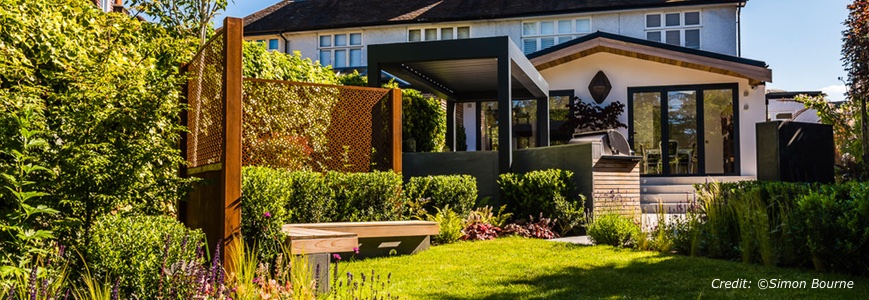
It’s that time of year again, with the nights drawing in, December fast approaching and the anticipation mounting it can mean only one thing...no not Christmas, the BALI National Landscape Awards 2018.
Recognised throughout the industry as one of the biggest landscaping events of the year the 42nd BALI National Landscape Awards will pay tribute to BALI members who have demonstrated exceptionally high standards of professionalism and skill within the landscaping and design sector.
As BALI members and winners of this years Domestic Garden Construction Between £100k - £250k category the Landscaping Solutions team will of course be in attendance.
This will be our fifth BALI award to date and, as always, it stands as a great testament to the hard work, craftsmanship and enthusiasm of all our staff. Two of those five award have been of ‘Principal’ status which is awarded to the best garden in its respective category. We are hoping that this year will be three out of five. Fingers crossed.
Situated in the London Borough of Barnet our award winning garden was designed by Jilayne Rickards Garden Design. Jilayne’s commitment and attention to details is of the highest order and we look forward to bringing more of her contemporary garden designs to life in coming years.
As part of the initial brief for this particular design the client had requested a usable family space with a unifying architectural theme and colour scheme. In addition they wanted year round interest in the planting, to hear the sound of running water and to have interesting textures, shapes and heights be incorporated in to the planting.
Modern hard landscaping features, privacy screens, overhead patio shades, a built-in barbecue and fireplace and a bespoke water feature are just some of the many features we installed to meet the clients needs.
In the early stages of the design process the client had also expressed the importance of ensuring the finished garden had a ‘unique’ and personal feel, requesting personalised elements be included in the scheme.
With this in mind a number of bespoke Cor-Ten features were commissioned and installed through the rear garden. A bespoke mounting method had to be devised to allow for their installation.
From these bespoke installations, through to restricted site access and unfavourable ground conditions it is fair to say the project was not without its challenges. Luckily we don’t shy away from challenges at Landscaping Solutions and so with good communication, meticulous planning and hard work we were able to transform the garden in to a clean and clear functional space that satisfied all of the clients requirements.
With the hard work done, We are certainly looking forward to celebrating with fellow BALI members at the awards ceremony in December and as always, it is an honour to have our achievements recognised by the industry's number one trade association and our peers.
The competition in each category is fierce so we would also like to take this opportunity to congratulate all the other category winners on a job well done.